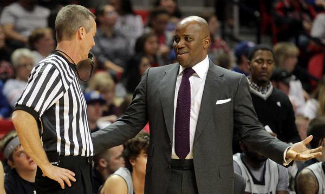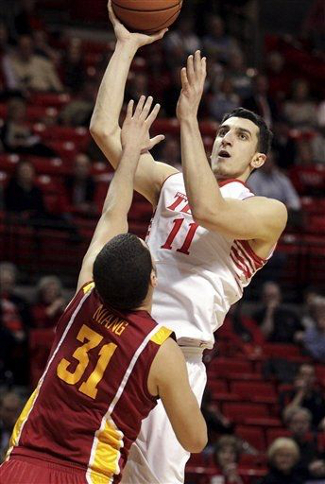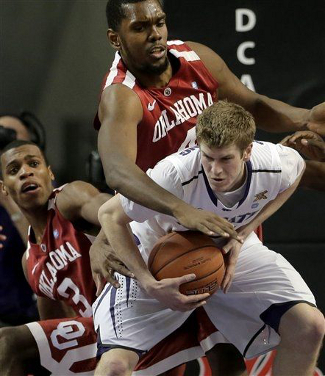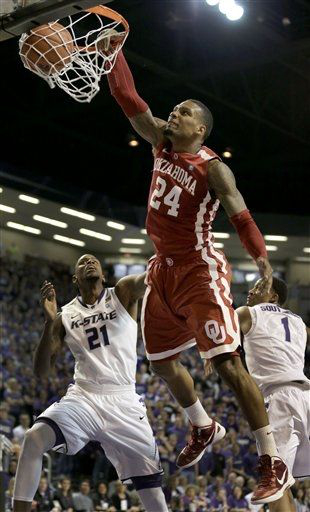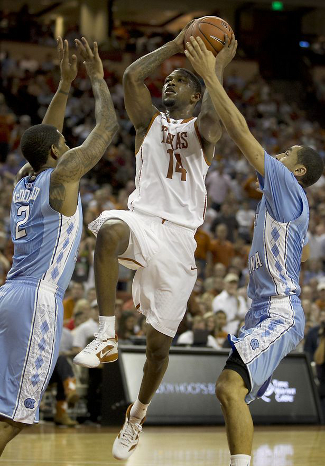#4/4 Kansas Jayhawks (15-1 overall, 3-0 Big 12) at Texas Longhorns (8-8, 0-3)
Erwin Center | Austin, TX | Tip: 1 P.M. CT | TV: CBS
LRT Consecutive Game #237
The last time the Texas Longhorns started conference play with an 0-4 mark, the team missed the NCAA tournament and Coach Tom Penders lost his job. It has been more than 14 years since that disastrous season, and the Longhorns have appeared in every NCAA tournament since then under Coach Rick Barnes. With this year’s squad sitting at 0-3 in the Big 12 and an incredibly talented Kansas team coming to the Erwin Center this afternoon, the chances are good that the Horns will be matching that disappointing start.
Although the Longhorns suffered a pair of their conference losses in overtime, they have yet to face a team as skilled as Kansas. The Jayhaws have won 14 straight games after losing to Michigan State in the Champions Classic, with their 12 non-conference wins coming by an average of more than 20 points.
While the number alone is impressive, considering the strength of KU’s non-conference schedule only makes it more extraordinary. Although the non-con slate included the likes of Southeast Missouri State, American, and Chattanooga, Kansas also knocked off good mid-majors in Belmont and Richmond, blew out Colorado, and defeated Ohio State on the road.
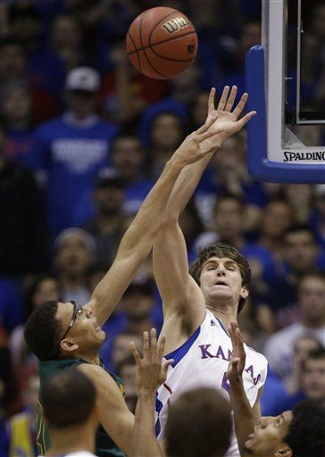
Jeff Withey anchors KU’s imposing interior defense
(Photo credit: Orlin Wagner/Associated Press)
By the numbers
As is to be expected with a Bill Self team, the Jayhawks are stout on both ends of the court. Their adjusted offensive efficiency is ranked 17th in the country by Ken Pomeroy, as the Jayhawks score 1.136 points per possession against the average defense. They are also fourth-best when it comes to stopping opponents, allowing an adjusted 0.838 points per possession.
There has been a slight drop-off for the Jayhawks on the offensive end in conference play, with the team scoring 1.047 points per possession. Their stifling defense has more than made up for slight dip in production, as the Jayhawks are limiting Big 12 foes to 0.85 points per possession, and held Baylor to 23.2% shooting from the field on Monday night.
Kansas’ interior defense is the toughest in the nation, as opponents make just 36% of their shots inside the arc. The team also has the second-best block rate in the country, swatting nearly 22% of the two-point attempts taken by their opponents. The dominant Big Monday win over Baylor drilled this point home, as the very tall Baylor lineup shot just 21.4% inside the arc and struggled to score the entire night.
Offensively, the Jayhawks have gradually become one of the nation’s best three-point shooting teams despite a slow start behind the arc. Kansas has made 36.8% of its threes this season, ranking the team 50th out of 347 in Division I. In the Jayhawks’ first six games, they hit just 29.6% of their three-pointers, even with an impressive 7-for-13 performance behind the arc against Saint Louis. Although the team has seen its average dip once again in conference play, its scorching-hot 47.8% mark in December has shown just how quickly Kansas can light it up from outside.
Meet the Jayhawks
The team’s leading scorer is freshman Ben McLemore (No. 23), who is far more experienced than most first-year players. He was deemed a partial qualifier last season and had to get his grades in order before he could even practice with the team. Naturally, Kansas used McLemore’s redshirt and kept him out of game action in the spring semester. That gave him a chance to practice with and against last year’s Final Four team, easing his adjustment to the college game.
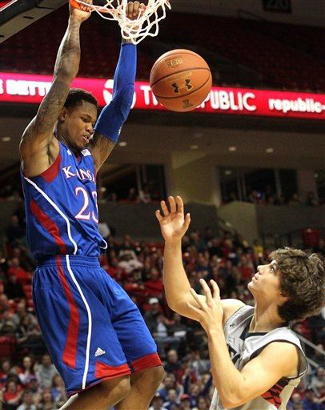
Ben McLemore is one of the nation’s best freshmen
(Photo credit: Stephen Spillman/Associated Press)
McLemore is a smooth scorer with an excellent jump shot that has been compared to that of Ray Allen. He elevates well above the defense and has perfect form, even when coming off a curl or taking a quick shot after the kickout. Although McLemore’s handles are not good enough to put him in a facilitating role, he can still drive from the perimeter and get to the rim. He has also shown some incredible athleticism on highlight reel dunks this season, so the Horns will have to put a body on him in offensive rebounding situations, unless they want to show up in a supporting role on Sportscenter.
The other player getting all of the press this year is senior Jeff Withey (No. 5), who is definitely worthy of all the attention. At 7-feet, he is the nation’s second-best shot blocker, swatting more than 17% of his opportunities. What makes him such an excellent defender, though, is that he does it all without fouling. Withey stays vertical and jumps straight to the ceiling, seriously altering any shots that he cannot block. His sound defensive fundamentals mean that he has been whistled for only 20 fouls in 16 games.
The other thing that Withey does remarkably well on the defensive end is keep his blocked shots in play. The Jayhawks are not a team that force an excessive number of turnovers, but they still have a very efficient transition game. A large part of that success is due to Withey’s ability to block shots inbounds, in addition to his willingness to immediately look up after securing defensive boards.
On the offensive end, Withey is a great passer in the post, allowing Self to use him in the high-low game. It also leads to easy buckets when Withey passes from block to block when opposing bigs help across the lane. The Jayhawks also love to use their big man in the pick and roll, setting him up for elementary finishes at the rim when defenders key on the Jayhawk drivers.
One of those drivers is Elijah Johnson (No. 15), who is the team’s point guard in title. Coach Self has pointed out that his team’s offense doesn’t have a true point after the first pass is made in the half court set, and Johnson’s game bears that out. EJ is a skilled slasher with slippery moves, but is also a great catch-and-shoot guy who will can it from outside on the drive-and-kick or quick ball reversals. He has also shown an affinity for the skip pass, frequently using it to set up McLemore in the far corner for threes.
The other guard in the starting five is senior Travis Releford (No. 24). Although he has been known throughout his career as a lockdown perimeter defender, Releford has upped his offensive game this season. He has hit more than 62% of his shots this year, and his true shooting percentage of 73.9% is best in the nation. Releford has made almost 42% of his threes, developed a midrange game, and consistently gets out and runs the floor well in transition to earn easy hoops.
At the four spot is Kevin Young (No. 40), the fourth senior in the team’s starting five. At 6’8″ and just 190 pounds, Young lacks the size of most four-men, but still manages to scrap on the glass. He is ranked in the top 100 for both offensive and defensive rebounding percentages, with his 14% mark on the offensive glass slotting him 54th in the nation.
Young’s other major impact is as a great interior passer. He has a nice, soft touch on his passes from the high post and knows where and when to hit Withey with the feed. Opponents such as Texas Tech have tried to force Young to beat them as they double down on Withey, with varying degrees of success. He doesn’t possess a consistent midrange shot, but will put the ball on the floor to drive from the free-throw line when opponents play off of him.
The one area of weakness for this Kansas team is its depth. The starting five account for 74.1% of the team’s minutes, a stat that is skewed by the blowouts in non-con play. In the team’s five games that were decided by ten points or less, the bench accounted for just 19.7% of Kansas’ minutes.
The reserve who has earned the most minutes this year is sophomore Naadir Tharpe (No. 1), who has logged about 18 minutes per game backing up Johnson at the point. Only 5’11”, Tharpe is very quick with the ball and pressures opponents well on the perimeter. His shot has been streaky this season, but it appears he is hitting his stride after a slow start. Tharpe made just six of his first 21 from behind the arc, but has upped his three-point percentage to 37.2% coming into this game.
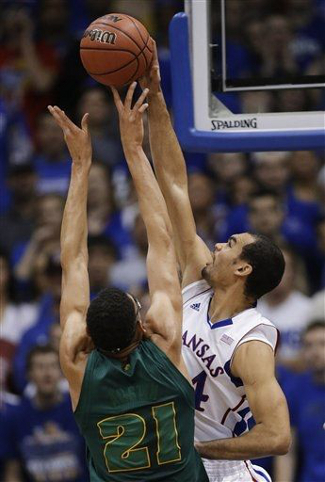
Perry Ellis is a promising freshman for Kansas
(Photo credit: Orlin Wagner/Associated Press)
Highly-touted recruit Perry Ellis (No. 34) has also seen action in every game, logging more than 14 minutes each night. At times, it has looked like Ellis lacks confidence, playing tentatively despite his natural skills. Like Withey, he knows how to hold his ground and play vertically on defense, and he works hard on the glass. With time, he should iron out the wrinkles in his offensive game and play with confidence on that end of the floor.
Like McLemore, Jamari Traylor (No. 31) was deemed a partial qualifier last season and used his redshirt. He is a high-motor guy who has thrown down some ferocious follow dunks in transition, and he is constantly working on the glass. Although he sees the court for just under 12 minutes per game, he looks like one of those prototypical Self players who has a small role as a freshman and then explodes as a sophomore or junior.
The Jayhawks also give minutes to freshmen Andrew White III (No. 3) and Rio Adams (No. 2), but usually when the game is out of reach. White is a 6’6″ swingman with a deadly three-point shot, while Adams is an exciting, athletic 6’3″ guard who often plays out of control. If Texas fans see either of these players for extended minutes this afternoon, it means that things have turned very ugly for the Longhorns.
Keys to the game
1) Handle the perimeter pressure – The Jayhawks do not force their opponents into many mistakes, but they do make it a point to force opposing guards out of their comfort zone. Kansas’ defensive turnover percentage of 19.3% is actually ranked 233rd in D-I, but they will pressure the ball well past the perimeter and hedge hard on ball screens.
The Texas offense has struggled throughout the season, but has had an especially difficult time when Javan Felix is unable to get free on high ball screens. The Longhorns also have made their most frustrating turnovers when passing it around the perimeter. Texas cannot afford to give up easy hoops with dumb turnovers behind the arc, and the team has to be able to find some offensive flow despite Kansas’ perimeter pressure.
2) Avoid taking challenged shots – The Longhorns will have a very tough time scoring at the rim in today’s game, as Withey’s presence typically cleans up any dribble penetration that opponents can muster. If Texas is going to score inside, it will have to come off of smart passing as Kansas rotates. If they cannot manage to do that, the Horns must avoid wasting possessions by forcing up bad looks against strong interior defense.
Although teams can score inside against KU with crisp passing and a little bit of basketball IQ, the most likely scenario is that Texas will have to knock down their jumpers to pull off a huge upset this afternoon. For a team that has an effective field goal mark of just 30.2%, that will be a very tall order.
3) Limit second chance points – Texas has been giving up offensive rebounds at the worst times this season, allowing both UCLA and West Virginia to win key boards in the final minutes. The Bruins and Mountaineers both took advantage of those extra opportunities to mount furious late-game comebacks and snatch victory away from Texas.
Although Kansas is ranked just above the national average when it comes to offensive rebounding, the Longhorns have to crash the defensive glass on every single possession. The Kansas offense is an efficient machine, and Texas cannot afford to waste their defensive stops by giving the Jayhawks extra chances to score.
| 







